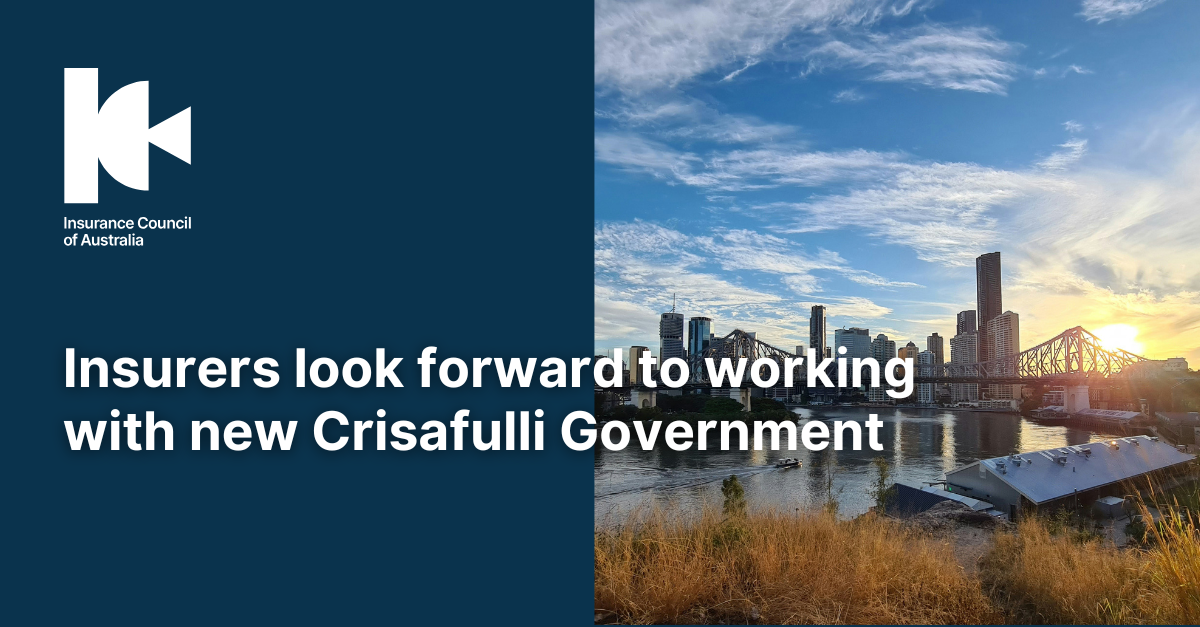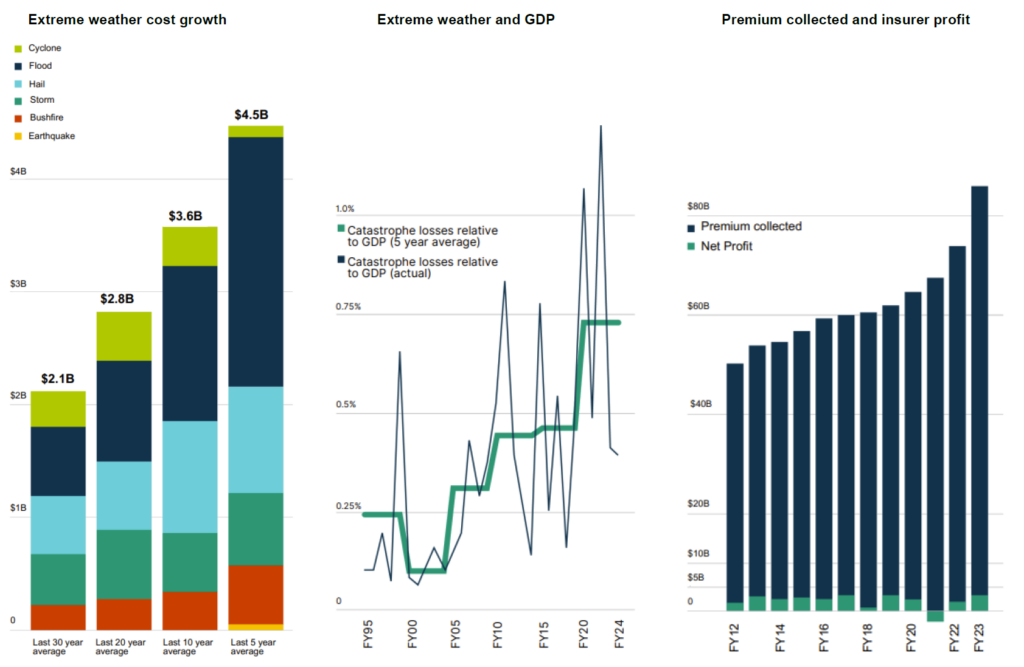Economy
Fact Sheet: Australia’s Insurance Industry Snapshot 2025
by insuranceca
Advancing Australia’s Resilience: Policy recommendations
by insuranceca
Home Economy
The ICA’s second annual Insurance Catastrophe Resilience Report uses insurer data and insights to review the last 12 months of extreme weather events and advocate for changes to reduce the impact of future events.
Insurers look forward to working with new Crisafulli Government
by insuranceca
Home Economy
Insurers look forward to working with new Crisafulli Government

News release
Sunday, 27 October 2024
The Insurance Council of Australia (ICA) today said insurers look forward to working with the new Crisafulli Government to better protect Queenslanders from the impacts of extreme weather.
Queensland is Australia’s most extreme weather-exposed state: around 75 per cent of all Australian homes in cyclonic wind regions are located in Queensland and it has the largest number of properties at risk of flood of any state or territory.
Last month the ICA published A Stronger Queensland, which outlined the policies needed to ensure Queenslanders remain protected and secure.
Analysis included in the report found that at least 310,000 Queensland properties – or around 10 per cent of all Queensland properties – are exposed to a 1-in-100, 1-in-50, or 1-in-20 risk of flooding each year, with at least 47,000 of these properties exposed to the highest 1-in-20 annual risk of flooding.
In the last three years insurers have incurred around $4.5 billion in extreme weather claims in Queensland.
The key insurance priorities for Queensland are:
- Reducing the cost of insurance by removing the nine per cent stamp duty paid on insurance policies
- Defending critical infrastructure, including homes and businesses, by substantially increasing funding to better protect against flood and cyclone
- Future proofing the State by stopping development on flood plains and making new homes more resilient to extreme weather
- Supporting the most vulnerable in the community with programs that reduce risk and put downward pressure on the cost of insurance.
Queenslanders could see an immediate reduction in their premiums if the Crisafulli Government removes stamp duty on insurance, which would provide immediate cost of living relief and encourage greater take-up of insurance at a time when it is needed most.
In the current financial year, Queenslanders are forecast to pay $1.7 billion in stamp duty on their insurance policies, up from just over $1 billion in 2019-20.
Quote attributable to Andrew Hall, CEO, Insurance Council of Australia:
The Insurance Council congratulates Premier-elect David Crisafulli and his team on their election victory yesterday and look forward to working with the new Government on our shared priorities of making Queensland safer and insurance more available.
The most immediate way to reduce insurance premiums in Queensland is abolishing the nine per cent stamp duty on insurance premiums.
If the Crisafulli Government does not abolish stamp duty on insurance, it should invest the revenue collected by this tax in mitigation initiatives that directly benefit Queenslanders and put downward pressure on insurance premiums.
Analysis undertaken for the ICA shows that a five-year, $730 million investment in mitigation projects across Queensland would deliver $6.3 billion in savings to 2050 – a nine-fold return on investment.
Insurance Catastrophe Resilience Report 2023-24
by insuranceca
Home Economy
The ICA’s second annual Insurance Catastrophe Resilience Report uses insurer data and insights to review the last 12 months of extreme weather events and advocate for changes to reduce the impact of future events.
New data shows long-term cost of extreme weather
by insuranceca
Home Economy
New data shows long-term cost of extreme weather
News release
Monday, 19 August 2024
New data released by the Insurance Council of Australia (ICA) today shows that the impact of extreme weather on the Australian economy has more than tripled over the last three decades.
Insured losses from declared insurance catastrophes have grown from 0.2 of GDP from 1995 to 2000 to 0.7 per cent for the last five years, meaning extreme weather losses are consuming more and more of our economic resources.*
In monetary terms, over the last 30 years insurers paid an average of $2.1 billion per year to customers impacted by extreme weather events, but looking at just the last five years the average annual cost of extreme weather claims has more than doubled to $4.5 billion, driven largely by the growing cost of flood.**
And while total premium collected by insurers has grown from $50 billion in 2012 to $86 billion in 2023 insurer profits have not kept pace, remaining flat over that period.***
The new data analysis is contained in the Insurance Council of Australia’s Insurance Catastrophe Resilience Report 2023-24, released today.
The Report shows that insurers incurred $2.19 billion in claims from declared extreme weather events in 2023-24, the same amount as was incurred from extreme weather events over the previous 12 months.
However, the number of claims from events in the past 12 months was almost 157,000, 66,000 more claims than the previous period, showing that while the average claim from recent weather events was lower the impact was more widespread.
The costliest extreme weather event of the past 12 months was the Christmas storms that impacted the Gold Coast hinterland as well as areas of New South Wales and Victoria, which drove $1.33 billion in claims.
The event with the greatest impact on individual customers was ex-TC Jasper which hit Far North Queensland in mid-December, where the average claim was $36,000, almost three times the average claim for the Christmas storms.
The Report outlines the policy solutions required to improve community and household resilience to extreme weather, which include improved land use planning, stricter building codes, and ongoing investment in resilience measures such as flood levees and home strengthening.
The Insurance Catastrophe Resilience Report 2023-24 will be launched at Parliament House, Canberra tonight.
www.insurancecouncil.com.au/CatastropheReport
Quote attributable to ICA CEO Andrew Hall:
The ICA’s latest Insurance Catastrophe Resilience Report shows the impact of extreme weather on our communities over the past 12 months.
Flood is Australia’s most costly natural peril, and it’s estimated that around 1.2 million properties face some level of flood risk.
Around 230,000 of these have a 1 in 20 chance of a flooding each year, with a further 420,000 properties facing a 1 in 50 or 1 in 100 annual chance of flooding, odds that translate into higher premiums which can lead to a growing protection gap.
In the last few years Australian policymakers have started to think more seriously about this issue, and in many ways we are leading the world in our approach to extreme weather risk mitigation and insurers’ product offerings that respond to these risks.
But we need to redouble our efforts if we are to manage the impact of worsening extreme weather amid a changing climate.
De-risking is the only sustainable way to reduce the pressure on premiums and close the protection gap: improved planning so no more homes are built in harm’s way, stronger buildings that are better able to withstand extreme weather, greater investment in public infrastructure to protect communities, and an ongoing program of home buybacks where no other mitigation is possible.
*ICA Catastrophe Loss data (5-year average) relative to GDP (GDP Index, ABS)
**ICA Catastrophe Loss data, adjusted for CPI
***Estimated from APRA’s published gross earned premium and increased for taxes and charges

- Page 1
- Page 2
- Page 3
- Interim pages omitted …
- Page 6
- Go to Next Page »


